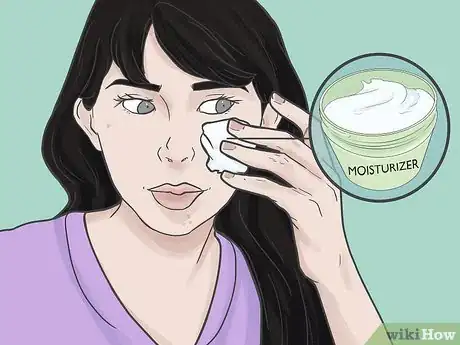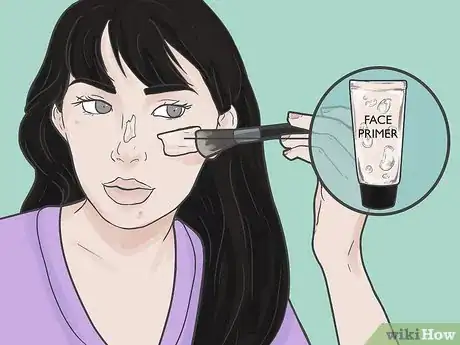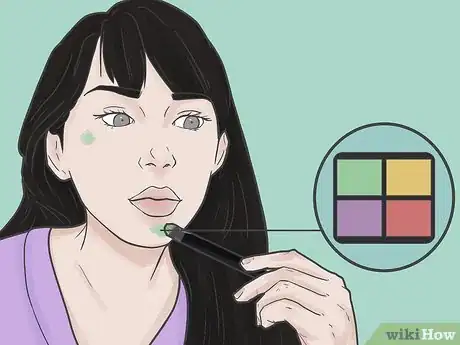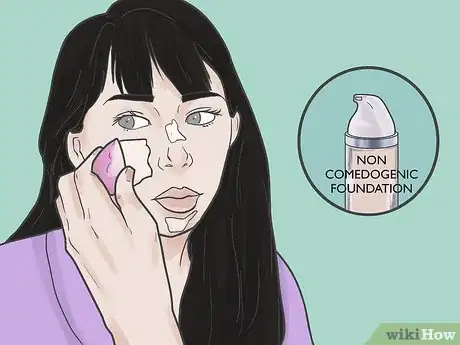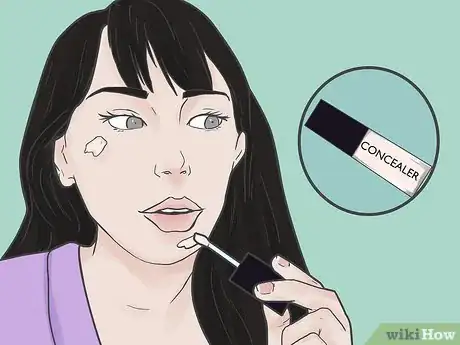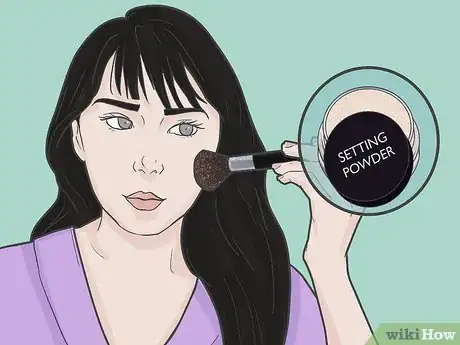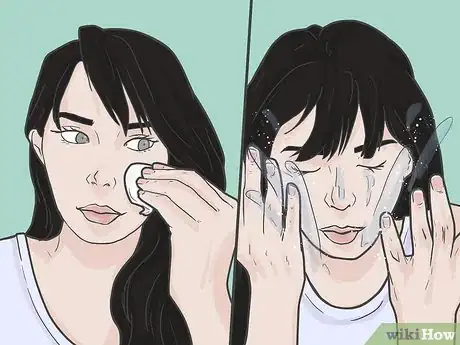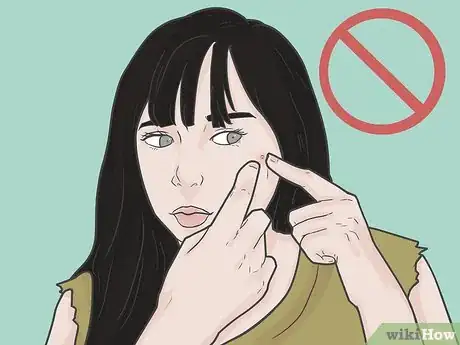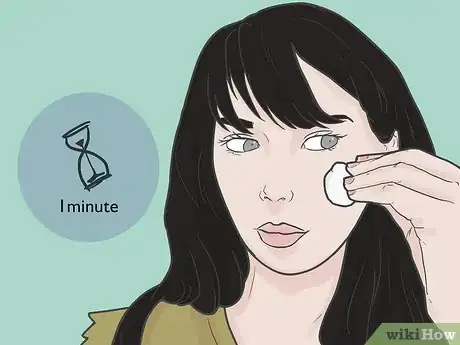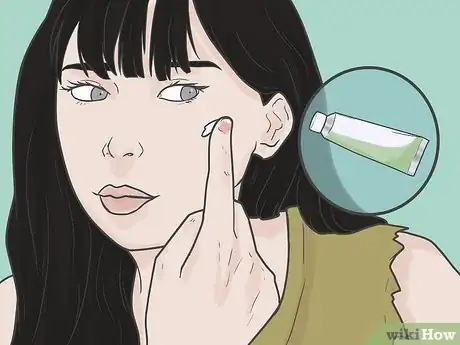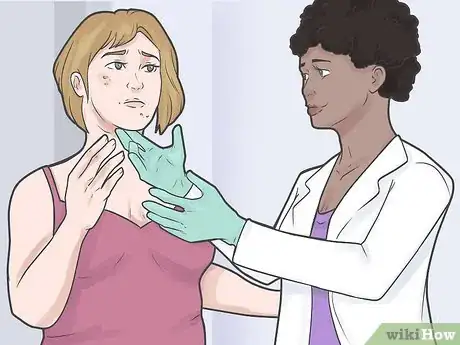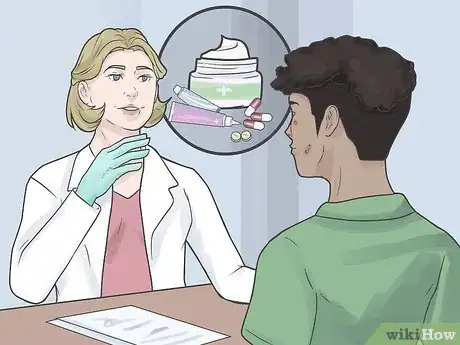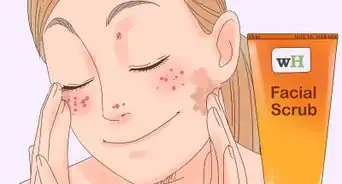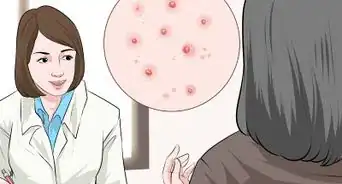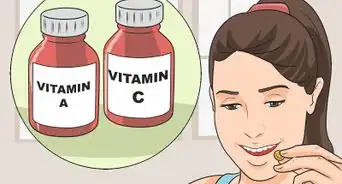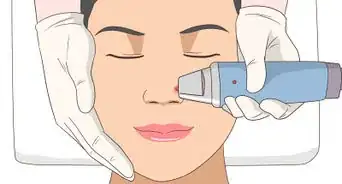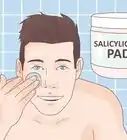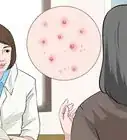This article was co-authored by Mohiba Tareen, MD and by wikiHow staff writer, Danielle Blinka, MA, MPA. Mohiba Tareen is a board certified Dermatologist and the founder of Tareen Dermatology located in Roseville, Maplewood and Faribault, Minnesota. Dr. Tareen completed medical school at the University of Michigan in Ann Arbor, where she was inducted into the prestigious Alpha Omega Alpha honor society. While a dermatology resident at Columbia University in New York City, she won the Conrad Stritzler award of the New York Dermatologic Society and was published in The New England Journal of Medicine. Dr. Tareen then completed a procedural fellowship which focused on dermatologic surgery, laser, and cosmetic dermatology.
There are 14 references cited in this article, which can be found at the bottom of the page.
This article has been viewed 7,718 times.
Although acne is very common, dealing with breakouts is still super annoying. As if having acne wasn’t bad enough, picking at your pimples can cause a scab to form, which makes the blemish more noticeable. Fortunately, you can hide your acne scabs so your skin looks clearer.
Steps
Covering Scabs with Makeup
-
1Apply a moisturizer to your scab, then dab away the excess. Acne scabs are typically dry and flaky, so they need more moisture. Use your normal facial moisturizer or petroleum jelly to moisten the scab.[1] Gently dot the cream onto your acne scab using your finger and let it dry for about a minute. Then, blot away any excess cream with a clean tissue.[2]
- In addition to helping the scab heal, moisturizer or petroleum jelly will improve the look and texture of your scab.
-
2Cover your face with a primer to help your makeup last longer. Primer is a skincare product that prepares your face for makeup. In addition to keeping your makeup in place longer, primer fills in your pores and covers blemishes to make your skin feel more even. Choose a primer that has a green or yellow base to mask the scar's redness.[3] Start by applying a coin-sized amount of primer to your nose. Then, use your fingers or a foundation brush to spread the primer out to the edges of your face. Let the primer dry for 1-2 minutes before continuing.[4]
- If you don't want to apply makeup or primer on your whole face, it’s okay to apply your primer directly to the scab. Dot the primer on with your fingertip or a concealer brush.
- You can purchase primer at a drug store, beauty supply store, or online.
Advertisement -
3Dab a color-correcting concealer onto your scab if you have it. Color-correcting concealer neutralizes the discoloration of your acne so it's easier to hide. Use a green concealer because it counteracts redness that's common with acne. Blend the color-corrector over the scab using your fingertip or a concealer brush. Let it dry for about 1 minute before continuing.[5]
- A little concealer goes a long way. You don’t need to apply much color-corrector to neutralize the discoloration.
- You’ll still be able to see the scab after applying the color-corrector.
-
4Apply a water-based non-comedogenic foundation to even out your skin. Check the label to make sure your foundation says it's non-comedogenic, which means it won't clog your pores. Then, use your fingers or a makeup blender ball to spread your foundation from your nose out to the edges of your face. When applying the foundation over your acne scab, gently dot the product onto the area. Blend out the foundation so you don’t have a harsh line around your face.[6]
- If you don't want to apply foundation to your entire face, you can apply your foundation to just the acne scab. Use your fingertip or a blender ball to dab the foundation directly onto your blemish. Then, blend the product out into the surrounding skin.
-
5Dab a flesh-colored concealer onto the scab to make it less visible. You’ll likely still see your acne scab after you apply foundation. To fully conceal it, add a thin layer of a concealer that matches your skin color on top of your foundation. Use your fingertip or a concealer brush to lightly dab the concealer over the scab.[7]
- Let your concealer dry for about a minute before you apply powder.
-
6Dust your face with a setting powder to keep your makeup in place longer. All of your hard work to cover your scab will be for nothing if your makeup comes off. Fortunately, setting powder may prevent that from happening. Dip your powder brush into your setting powder, then shake off any excess. Lightly brush the powder over your entire face.[8]
- If you're only wearing makeup on your acne scab, use a small makeup brush to apply the powder to just the scab.
- You can use setting spray instead of powder if you prefer. Simply mist your face with the spray to help your makeup last.
-
7Wash off your makeup before bed to minimize future breakouts. While makeup is a great way to hide acne scabs, it won’t help them heal. In fact, wearing makeup to bed can actually make your acne worse. Cleanse your face every night as part of your bedtime routine.[9] Apply a face cleanser to your skin using your fingers, then wash it off with lukewarm water.[10]
- You may prefer to use a cleansing wipe to remove your makeup. However, you still need to wash your face afterwards to get it completely clean.
Reducing Redness and Swelling
-
1Stop picking your skin so it can start to heal. You probably know that you’re not supposed to pick your pimples, but it’s super hard to stop. You may be especially tempted to pick off the skin around your scab or the scab itself. Resist the urge! Keep your hands away from your face so your scab can start to heal.[11]
- If you’re having trouble not picking your face, do something that occupies your hands, like knitting or molding clay.
Did You Know? Your body forms scabs as part of the healing process. Leave the scab in place so your skin completely heals. If you pick off the scab, your skin will likely just form another one.[12]
-
2Dab cleanser onto the scab and let it sit for 1 minute to reduce swelling. Applying cleanser will clean the area and might make your scab look less noticeable. Use your finger to dab a drop of your regular face cleanser onto the scab. Wait 1 minute, then wash the area with lukewarm water.[13]
- Any cleanser will work, so just use what you have. It doesn’t need to be formulated to treat acne.
- Only do this treatment once a day, in addition to your regular skin routine. If you do it too often, the cleanser may dry out your skin more.
-
3Hold ice against the scab to reduce redness and inflammation. You likely know that ice helps with swelling, but you might not think about using it on your acne. Wrap an ice cube in a towel, as the fabric can protect your skin from the cold. Then, hold the ice against your acne scab for 1-2 minutes. Check your skin to see if it looks better. Reapply the ice for another 1-2 minutes if necessary.[14]
- Remove the ice from your skin if you experience any pain or discomfort.
-
4Apply a spot treatment to the acne scab to help it heal. A spot treatment may help heal your pimple scab faster. Pick an acne treatment that contains salicylic acid or benzoyl peroxide. Put a dot of the treatment onto the tip of your finger, then dab it onto the acne scab. Do this once a day to help your scab heal faster.[15]
- You may be tempted to apply the treatment several times a day in hopes of getting faster results. However, this can dry out your skin and make the scab worse.
Getting a Professional Treatment
-
1Visit a dermatologist if your acne bothers you. You may be able to treat your acne and any acne scabs you have at home. However, see a dermatologist if your skin doesn’t improve, you’re frequently getting scabs, or you have acne scars.[16] They can recommend skin treatments to help your skin heal.[17]
- Get a referral to a dermatologist from your doctor or look for one online.
- Your insurance may cover visits to a dermatologist, so check your benefits.
-
2Ask about medications to heal acne and reduce scarring.[18] Unfortunately, acne scabs can turn to scars. If you have persistent acne or already have acne scarring, medication may help clear your skin by treating bacteria, speeding up cell turnover, reducing inflammation, or reducing oil production. Once you start using a medication, it may take 4-8 weeks to see results. Talk to your doctor to find out if 1 or more of the following medications may be right for you:[19]
- Topical retinoids help prevent your hair follicles from getting clogged.
- Topical antibiotics kill bacteria and reduce redness.
- Topical salicylic acid may help prevent clogged hair follicles.
- Topical azelaic acid may help kill bacteria.
- Topical dapsone may help treat inflammatory acne.
- Oral antibiotics kill bacteria and reduce inflammation.
- Combined oral contraceptives may treat hormonal acne in women who aren't trying to become pregnant.
- Oral anti-androgen agents may help treat acne in young women who don't want to become pregnant by reducing oil production and lowering androgen hormones.
- Oral isotretinoin is a powerful acne treatment that may be prescribed for severe acne that doesn't respond to other treatments.
-
3Talk to your doctor about skin treatments for clearer skin. If nothing seems to help, don't despair! There are treatments available to help clear your skin and minimize the appearance of scars. Discuss your treatment options with your dermatologist to see what might work for you. They may recommend one of the following treatments:[20]
- Light-based therapy: During light therapy, your doctor will use a special device to shine blue, red, blue + red, or infrared light on your acne. Over time, the treatment may help clear your skin, but everyone's results are different. With Photodynamic therapy (PDT), your doctor will apply a solution to your skin before light therapy to make your skin more sensitive to the treatment. This treatment shouldn’t be painful but you may experience discomfort.[21]
- Chemical peel: Your dermatologist may apply a chemical like salicylic acid, glycolic acid, or retinoic acid to your skin to help improve cell turnover. The chemical will remove your outer layer of skin cells, revealing clearer skin. You’ll need to get repeated treatments to maintain your results. Also, you might experience some discomfort during treatment.[22]
Warnings
- Don’t pick your acne, as this causes scabbing and scarring.[24]⧼thumbs_response⧽
References
- ↑ Mohiba Tareen, MD. FAAD Board Certified Dermatologist. Expert Interview. 26 March 2020.
- ↑ https://www.youtube.com/watch?v=INEArF9jf4Y&feature=youtu.be&t=12
- ↑ Ashleigh Grounds. Makeup Artist & Hair Stylist. Expert Interview. 22 April 2020.
- ↑ https://www.youtube.com/watch?v=RsDoGTc9BCM&feature=youtu.be&t=53
- ↑ https://www.youtube.com/watch?v=MDautcYtZ28&feature=youtu.be&t=95
- ↑ https://www.nhsinform.scot/illnesses-and-conditions/skin-hair-and-nails/acne
- ↑ https://www.ncbi.nlm.nih.gov/pmc/articles/PMC6715335/
- ↑ https://www.youtube.com/watch?v=rNah2ujzIT0&feature=youtu.be&t=224
- ↑ Mohiba Tareen, MD. FAAD Board Certified Dermatologist. Expert Interview. 26 March 2020.
- ↑ https://www.nhsinform.scot/illnesses-and-conditions/skin-hair-and-nails/acne
- ↑ https://www.nhsinform.scot/illnesses-and-conditions/skin-hair-and-nails/acne
- ↑ https://www.aafp.org/afp/2004/0601/p2647.html
- ↑ https://www.youtube.com/watch?v=k_C1pWk46yQ&feature=youtu.be&t=14
- ↑ https://www.skincare.com/article/how-to-cover-acne-without-concealer
- ↑ https://www.skincare.com/article/how-to-cover-acne-without-concealer
- ↑ Mohiba Tareen, MD. FAAD Board Certified Dermatologist. Expert Interview. 26 March 2020.
- ↑ https://www.nhsinform.scot/illnesses-and-conditions/skin-hair-and-nails/acne
- ↑ Mohiba Tareen, MD. FAAD Board Certified Dermatologist. Expert Interview. 26 March 2020.
- ↑ https://www.mayoclinic.org/diseases-conditions/acne/diagnosis-treatment/drc-20368048
- ↑ https://www.mayoclinic.org/diseases-conditions/acne/diagnosis-treatment/drc-20368048
- ↑ https://www.aad.org/public/diseases/acne/derm-treat/lasers-lights
- ↑ https://www.mayoclinic.org/tests-procedures/chemical-peel/about/pac-20393473
- ↑ https://www.nhsinform.scot/illnesses-and-conditions/skin-hair-and-nails/acne
- ↑ https://www.nhsinform.scot/illnesses-and-conditions/skin-hair-and-nails/acne
